Farm and livestock fencing is integral to agricultural history, and as things in this industry evolve, so does the types of fencing that’s used. This evolution reflects advancements in technology, changes in farming practices, and regional differences across the United States.
From simple wooden fences to modern electric fencing, the types and styles used on farms have adapted to meet the needs of farmers and livestock owners based on terrain, climate, agricultural practices, and historical influences.
Take a look at some of the types of fencing that have been most popular in agriculture and how the shift over the past century has impacted livestock handling and overall food production:
Stone walls and corrals
In the 19th century and into the early 20th century, wooden fences and stone walls were the primary forms of agricultural fencing. Wooden post-and-rail fences were common in the eastern United States, where timber was readily available. These fences were labor-intensive to build and maintain but provided a sturdy barrier for livestock.
In New England, stone walls are still prevalent, originally constructed from the abundant rocks cleared from fields. These walls were durable and effective in keeping livestock contained, and as farmers worked fields, they pulled up plow-impeding stones and piled them on the edges of the field.
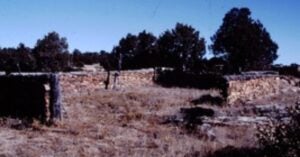
Although wooden corrals are more typical, rock corrals, built to hold livestock and horses, can still be found across the West.
Today, livestock corrals and working facilities are still built using cost-effective, readily available, sturdy materials. Portable panel systems allow farmers and ranchers to work stock without moving them to a permanent corral system. Meanwhile, corrals are constructed of wood, wood, wire, guard rails, continuous metal fencing bolted to posts, and more.
Wood fences and corrals
Wooden fencing has evolved alongside agricultural practices throughout history. During the expansion of agriculture in the Americas, settlers relied heavily on wood fencing to establish homesteads and manage livestock on vast prairies and farmlands. The availability of timber and the craftsmanship of early settlers shaped the diverse styles of wooden fencing seen across different regions.
Today, wooden fencing remains popular for its durability, versatility, and natural aesthetic. Advances in treatment and wood preservation have extended the lifespan of wooden fences, making them a sustainable choice for modern farms and ranches.
The wood selected for corral systems (and fencing) varies based on availability and durability requirements. While pine is an option that works well in milder climates, harsher climates require treated pine. Cedar is among the most used woods for ranch fencing because it repels pests and remains durable even in some of the harshest climates.
Different styles of wooden fencing can be found in different areas based on aesthetic appeal and functionality as well.
Snake rail fences, for example, also known as zigzag or worm fences, are characterized by their zigzagging pattern. They consist of horizontally placed rails that weave through vertical posts without the use of nails or fasteners, relying on the weight and placement of the rails to maintain stability.

Snake rail fences were popular in early American frontier regions for enclosing fields and livestock, offering a simple yet effective barrier against wandering animals.
Meanwhile, split rail fences are perhaps the most recognizable type of wooden fence in rural America. They are constructed from logs that have been split lengthwise into rails, typically with a triangular cross-section. These rails are then stacked horizontally between upright posts.

Ranch rail fences, also known as post and rail fences, are characterized by their sturdy construction and straightforward design. They consist of vertical posts spaced at intervals with horizontal rails running between them.
Depending on the aesthetic preference and function, ranch rail fences may feature two, three, or more horizontal rails. The spacing between rails can also vary, affecting the fence’s ability to contain livestock effectively.
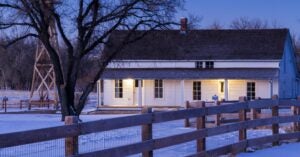
Another solution for fencing rocky, mountainous, or forested areas is jack fencing, also known as “buck and rail” or “jackleg” fencing.
The design consists of wooden rails resting on wooden “jacks” or “bucks” that hold the rails off the ground. This fencing style is well-suited for rugged terrains and has been widely used in regions with abundant timber resources.
Jack fencing has roots in early American history, dating back to the Colonial era. Early settlers in the Appalachian Mountains and other heavily forested areas needed a practical solution for fencing their land. The abundance of timber made jack fencing an ideal choice, as it required no nails or hardware and could be constructed using readily available materials.

The use of jack fencing expanded westward during the 19th century as settlers moved into the Rocky Mountains and other remote areas. Its portability and ease of construction made it popular among homesteaders and ranchers who needed to enclose large areas quickly and efficiently. The design allowed fences to be built on uneven ground and moved as needed, which was especially useful for seasonal grazing and protecting crops from wildlife.
Historically, jack fences were constructed from local timber, often using logs from trees like pine, spruce, or cedar. The logs were typically peeled to remove bark and reduce moisture retention, which helped prevent rot. Today, treated lumber or composite materials may be used for increased durability.
While jack fencing has largely been replaced by more modern fencing techniques in many areas, it still finds use in specific contexts. National parks, historical sites, and rural properties often use jack fencing for its traditional look and practical advantages. Contemporary versions may incorporate treated wood or composite materials to increase longevity and reduce maintenance.
Barbed wire makes its way West
As American settlers — primarily farmers — moved to the South and West looking for new land, they often found themselves in treeless land with few stones, where wooden fences were difficult to come by. The introduction of barbed wire in the late 19th century revolutionized fencing. Barbed wire fencing first appeared in 1873 at the DeKalb County Fair in Illinois, where a farmer presented the original idea.
On November 24, 1874, the U.S. Patent Office awarded Joseph Glidden a patent for an “Improvement in Wire-Fences.”
By the mid-20th century, barbed wire had become the dominant form of fencing across the Great Plains and western states. It was inexpensive, easy to install, and effective at containing cattle. Barbed wire, also called the “Devil’s Rope,” turned the plains from an open range into ranches and farmland.
The widespread use of barbed wire in the West also led to conflicts, particularly during the late 19th century in what was known as Range Wars. These disputes often arose between cattle ranchers, who relied on open ranges for grazing, and farmers who sought to fence off their property.
Virtually all barbed wire was patented between 1853 and 1897, and most patents were issued between 1876 and 1886. Over time, various types of barbed wire have been developed to meet different needs and preferences.
As patents were being issued, some homesteaders began making their own barbed wire using models they were already familiar with. According to the National Park Service, over 2,000 variations on over 500 barbed wire patents can be viewed in barbed wire displays.

Some of the original styles of barbed wire include:
- Glidden’s barbed wire (1874): Joseph Glidden’s original design featured two wire strands twisted together with two-pointed barbs spaced along the length
- T.V. Allis “Buckthorn” (1881): Steel ribbon fencing with one smooth edge and one pointed edge with barbs at one-inch intervals
- Kelly’s “Diamond Point” (1868): Right twisted barb clamped on line wire
- Single-strand barbed wire: Consists of a single wire with barbs attached at regular intervals
Today, you’ll find different methods of installing barbed wire fencing depending on the soil and topography.
In rocky areas, or those tough to reach with equipment, metal T-posts and wire fencing clips are incorporated to divide livestock pastures and fence off farm fields. Posts are driven by metal post pounders, which may even come air or gas-powered.
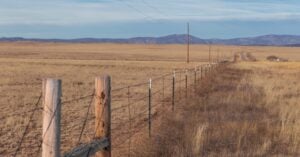
In areas that are more easily accessible, treated wooden posts are driven into the ground, and wire is stretched through fencing staples.
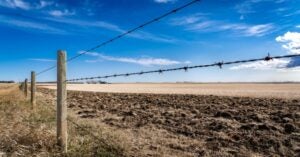
Even the braces that allow fences to be stretched tight vary based on the area and needs. Where pipe is easy to come by, H-braces may be built, welded, and set into concrete. Many older H-braces are built from creosote-treated railroad ties, but as they’ve become more expensive and difficult to find, many have opted for building wooden H-braces out of standard treated posts.
Corner braces may even be made of stacked rock wrapped with woven wire in places where the ground is too rocky and hard to dig.
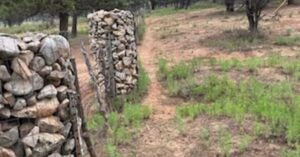
Woven wire fencing
As sheep entered the picture in the latter half of the 19th century, woven wire fencing emerged as an alternative, particularly for smaller livestock like sheep and goats.
Although woven wire fencing was used in England in the 1840s, Charles Bernard developed a machine for weaving wire into chain link mesh in the UK in 1844. The invention of woven wire fencing was officially credited in 1883. This type of fencing featured horizontal and vertical wires woven together to form a mesh. It provided a safer and more secure enclosure for smaller animals and became popular in the Midwest and parts of the South.
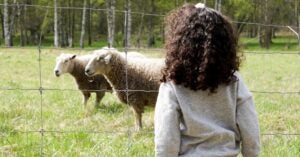
Woven wire fencing is still a popular choice for farm and livestock management due to its durability, effectiveness, and versatility. It comes in various types, each suited for different purposes and animals.
Field fencing, also known as farm fencing, is commonly used for general livestock containment. It’s made of heavy-gauge wire and typically comes in rolls of various heights and lengths. The mesh is usually larger at the top and smaller at the bottom, preventing animals from sticking their heads through.
There is also a specifically designed fencing used to contain smaller livestock in sheep and goat fencing, which features tighter mesh spacing to prevent animals from slipping through or getting stuck. The mesh in this fence includes small, uniform squares or rectangles.
Meanwhile, horse fencing was specifically designed with safety in mind for horses. Smaller at the bottom, and larger at the top, it prevents entanglement of this injury-prone species.
N0-climb fencing is also designed to prevent livestock such as horses from stepping through or climbing over the fence.
Of course, there is also woven wire fencing made specifically with poultry and small animals in mind. This fencing includes mesh that’s very small, and either hexagonal or rectangular in shape.
Electric fencing becomes popular
In the latter half of the 20th century, electric fencing gained popularity. Originally developed in New Zealand, electric fencing provided a flexible and cost-effective solution for managing livestock. These fences used electrified wires to deliver a mild shock to animals that touched them, encouraging them to stay within the enclosed area.
The mild shock delivered by electric fencing are typically enough to deter animals without causing harm, promoting livestock management. It’s also effective for a wide range of livestock, from cattle and horses to sheep, goats, and even poultry, making it a versatile choice for farming operations.
Electric fencing was also adaptable to various terrains. Electric fences are generally more affordable to install and maintain, especially over large areas.
Power sources used for fencing include battery power, useful in remote sources. While main electricity sources that include permanent installations can be found on larger farms and ranches, solar panels provide another option for remote areas that have enough sunlight, allowing the sun to charge batteries.
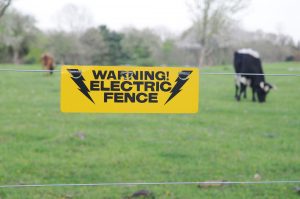
Even electrical fencing options include a variety of materials and styles. Metal wire is the most traditional and widely used material, but tape made from materials like polyethylene or polyester offers higher visibility and may be more suitable for horses and other animals that are sensitive to physical barriers.
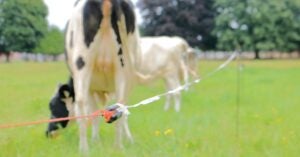
Electric netting consists of interconnected strands of electrified wire or tape woven into a mesh. It is often used for temporary enclosures or rotational grazing systems where flexibility and ease of setup are crucial. Electric netting is effective for containing poultry, sheep, and other small livestock.
An evolving technology
New technologies such as digital fencing are being studied and piloted, which use GPS, solar power, and electrical shock collars to virtually fence livestock into specific areas.
Today, modern fencing materials and technologies continue to evolve. These advancements have not only improved the efficiency of livestock management but also enhanced sustainability and adaptability across diverse terrains
»Related: Understanding different fence types and their impact on livestock security
Heidi Crnkovic, is the Associate Editor for AGDAILY. She is a New Mexico native with deep-seated roots in the Southwest and a passion for all things agriculture.



